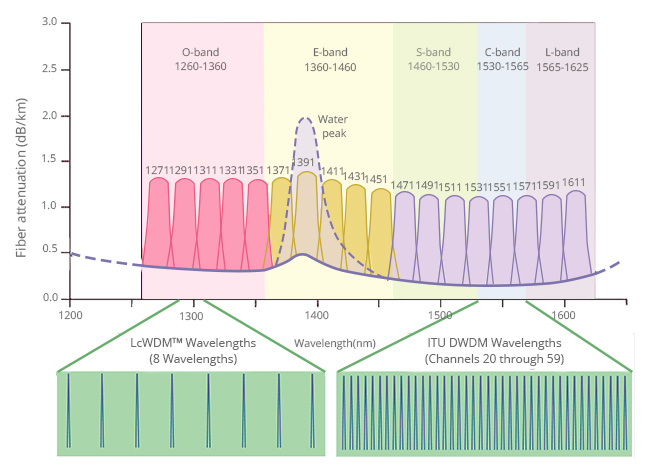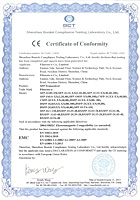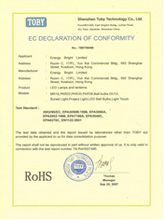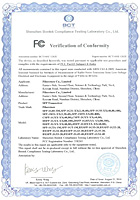DWDM-SFP10G-40(SMF, 1528.77nm to 1563.86nm, 40km, LC, DOM)
DWDM-SFP10G-40 10GBASE SFP+ Transceiver supports link lengths of 40km on single-mode fiber cable, at a wavelength of 1528.77nm to 1563.86nm.
It primarily enables bandwidth 10G optical links over 9/125μm single-mode fiber terminated with LC connectors and can be used in commercial temperature environment for interoperability with 10GBASE interfaces.
Digital optical monitoring (DOM) support is present to allow access to real-time operating parameters, which means, we are now by using DOM capable of performing transceiver monitoring and troubleshooting operations.
It primarily enables bandwidth 10G optical links over 9/125μm single-mode fiber terminated with LC connectors and can be used in commercial temperature environment for interoperability with 10GBASE interfaces.
Digital optical monitoring (DOM) support is present to allow access to real-time operating parameters, which means, we are now by using DOM capable of performing transceiver monitoring and troubleshooting operations.
Details
| Form Type: SFP+ | Data Rate: 10 Gbps |
| Wavelength : 1528.77nm to 1563.86nm | Max Cable Distance: 40km |
| Interface : LC duplex | Optical Components: EML DWDM |
| Cable Type: SMF | DOM Support: YES |
| Commercial Temperature Range:0 to 70°C (32 to 158°F) | HTS-Harmonized Code: 8517706000 |
| Channel | Frequency (THz) | Center Wavelength (nm) | Channel | Frequency (THz) | Center Wavelength (nm) |
| 17 | 191.7 | 1563.86 | 40 | 194 | 1545.32 |
| 18 | 191.8 | 1563.05 | 41 | 194.1 | 1544.53 |
| 19 | 191.9 | 1562.23 | 42 | 194.2 | 1543.73 |
| 20 | 192 | 1561.41 | 43 | 194.3 | 1542.94 |
| 21 | 192.1 | 1560.61 | 44 | 194.4 | 1542.14 |
| 22 | 192.2 | 1559.79 | 45 | 194.5 | 1541.35 |
| 23 | 192.3 | 1558.98 | 46 | 194.6 | 1540.56 |
| 24 | 192.4 | 1558.17 | 47 | 194.7 | 1539.77 |
| 25 | 192.5 | 1557.36 | 48 | 194.8 | 1538.98 |
| 26 | 192.6 | 1556.55 | 49 | 194.9 | 1538.19 |
| 27 | 192.7 | 1555.75 | 50 | 195 | 1537.4 |
| 28 | 192.8 | 1554.94 | 51 | 195.1 | 1536.61 |
| 29 | 192.9 | 1554.13 | 52 | 195.2 | 1535.82 |
| 30 | 193 | 1553.33 | 53 | 195.3 | 1535.04 |
| 31 | 193.1 | 1552.52 | 54 | 195.4 | 1534.25 |
| 32 | 193.2 | 1551.72 | 55 | 195.5 | 1533.47 |
| 33 | 193.3 | 1550.92 | 56 | 195.6 | 1532.68 |
| 34 | 193.4 | 1550.12 | 57 | 195.7 | 1531.9 |
| 35 | 193.5 | 1549.32 | 58 | 195.8 | 1531.12 |
| 36 | 193.6 | 1548.51 | 59 | 195.9 | 1530.33 |
| 37 | 193.7 | 1547.72 | 60 | 196 | 1529.55 |
| 38 | 193.8 | 1546.92 | 61 | 196.1 | 1528.77 |
| 39 | 193.9 | 1546.12 |
Spectral Attenuation Measurement
WDM systems are divided into different wavelength patterns, conventional/coarse (CWDM) and dense (DWDM). Conventional WDM systems provide up to 8 channels in the 3rd transmission window (C-Band) of silica fibers around 1550nm. Dense wavelength division multiplexing (DWDM) uses the same transmission window but with denser channel spacing. Channel plans vary, but a typical system would use 40 channels at 100 GHz spacing or 80 channels with 50 GHz spacing.Dense wavelength division multiplexing (DWDM) refers originally to optical signals multiplexed within the 1550nm band so as to leverage the capabilities (and cost) of erbium doped fiber amplifiers (EDFAs), which are effective for wavelengths between approximately 1525–1565nm (C band), or 1570–1610nm (L band).






![[ BiDi SFP+ ] 10GBASE 1330nmTX/1270nmRX BiDi SFP+ 20km DOM Transceiver](https://firstfiber.tech/media/catalog/product/cache/1/thumbnail/50x/9df78eab33525d08d6e5fb8d27136e95/t/r/transceivers.jpg)
![[ BiDi SFP+ ] 10GBASE 1270nmTX/1330nmRX BiDi SFP+ 20km DOM Transceiver](https://firstfiber.tech/media/catalog/product/cache/1/thumbnail/50x/9df78eab33525d08d6e5fb8d27136e95/t/r/transceivers_1.jpg)
![[ BiDi SFP+ ] 10GBASE 1270nmTX/1330nmRX BiDi SFP+ 10km DOM Transceiver](https://firstfiber.tech/media/catalog/product/cache/1/thumbnail/50x/9df78eab33525d08d6e5fb8d27136e95/t/r/transceivers_1_1.jpg)
![[ BiDi SFP+ ] 10GBASE 1270nmTX/1330nmRX BiDi SFP+ 60km DOM Transceiver](https://firstfiber.tech/media/catalog/product/cache/1/thumbnail/50x/9df78eab33525d08d6e5fb8d27136e95/t/r/transceivers_1_1_1.jpg)
![[ BiDi SFP+ ] 10GBASE 1330nmTX/1270nmRX BiDi SFP+ 80km DOM Transceiver](https://firstfiber.tech/media/catalog/product/cache/1/thumbnail/50x/9df78eab33525d08d6e5fb8d27136e95/t/r/transceivers_1_1_1_1.jpg)
![[ BiDi SFP+ ] 10GBASE 1270nmTX/1330nmRX BiDi SFP+ 80km DOM Transceiver](https://firstfiber.tech/media/catalog/product/cache/1/thumbnail/50x/9df78eab33525d08d6e5fb8d27136e95/t/r/transceivers_1_1_1_1_1_1.jpg)
![[ BiDi SFP+ ] 10GBASE 1270nmTX/1330nmRX BiDi SFP+ 40km DOM Transceiver](https://firstfiber.tech/media/catalog/product/cache/1/thumbnail/50x/9df78eab33525d08d6e5fb8d27136e95/t/r/transceivers_1_1_1_1_1_1_1.jpg)
![[ BiDi SFP+ ] 10GBASE 1330nmTX/1270nmRX BiDi SFP+ 40km DOM Transceiver](https://firstfiber.tech/media/catalog/product/cache/1/thumbnail/50x/9df78eab33525d08d6e5fb8d27136e95/t/r/transceivers_1_1_1_1_1_1_1_1.jpg)
![[ BiDi SFP+ ] 10GBASE 1330nmTX/1270nmRX BiDi SFP+ 10km DOM Transceiver](https://firstfiber.tech/media/catalog/product/cache/1/thumbnail/50x/9df78eab33525d08d6e5fb8d27136e95/t/r/transceivers_1_1_1_1_1_1_1_1_1.jpg)
![[ BiDi SFP+ ] 10GBASE 1330nmTX/1270nmRX BiDi SFP+ 60km DOM Transceiver](https://firstfiber.tech/media/catalog/product/cache/1/thumbnail/50x/9df78eab33525d08d6e5fb8d27136e95/t/r/transceivers_1_1_1_1_1_1_1_1_1_1.jpg)
![[ CWDM SFP+ ] 10GBASE 1270nm~1330nm CWDM SFP+ 10km DOM Transceiver](https://firstfiber.tech/media/catalog/product/cache/1/thumbnail/50x/9df78eab33525d08d6e5fb8d27136e95/t/r/transceivers_4.jpg)
![[ CWDM SFP+ ] 10GBASE 1350nm~1610nm CWDM SFP+ 10km DOM Transceiver](https://firstfiber.tech/media/catalog/product/cache/1/thumbnail/50x/9df78eab33525d08d6e5fb8d27136e95/t/r/transceivers_4_1.jpg)
![[ CWDM SFP+ ] 10GBASE 1470nm~1610nm CWDM SFP+ 80km DOM Transceiver](https://firstfiber.tech/media/catalog/product/cache/1/thumbnail/50x/9df78eab33525d08d6e5fb8d27136e95/t/r/transceivers_4_1_1.jpg)
![[ CWDM SFP+ ] 10GBASE 1470nm~1610nm CWDM SFP+ 40km DOM Transceiver](https://firstfiber.tech/media/catalog/product/cache/1/thumbnail/50x/9df78eab33525d08d6e5fb8d27136e95/t/r/transceivers_4_1_1_1.jpg)
![[ CWDM SFP+ ] 10GBASE 1270nm~1330nm CWDM SFP+ 20km DOM Transceiver](https://firstfiber.tech/media/catalog/product/cache/1/thumbnail/50x/9df78eab33525d08d6e5fb8d27136e95/t/r/transceivers_4_1_1_1_1.jpg)
![[ CWDM SFP+ ] 10GBASE 1270nm~1450nm CWDM SFP+ 40km DOM Transceiver](https://firstfiber.tech/media/catalog/product/cache/1/thumbnail/50x/9df78eab33525d08d6e5fb8d27136e95/t/r/transceivers_4_1_1_1_1_1.jpg)
![[ CWDM SFP+ ] 10GBASE 1270nm~1450nm CWDM SFP+ 60km DOM Transceiver](https://firstfiber.tech/media/catalog/product/cache/1/thumbnail/50x/9df78eab33525d08d6e5fb8d27136e95/t/r/transceivers_4_1_1_1_1_1_1.jpg)
![[ CWDM SFP+ ] 10GBASE 1350nm~1450nm CWDM SFP+ 20km DOM Transceiver](https://firstfiber.tech/media/catalog/product/cache/1/thumbnail/50x/9df78eab33525d08d6e5fb8d27136e95/t/r/transceivers_5.jpg)
![[ CWDM SFP+ ] 10GBASE 1470nm~1610nm CWDM SFP+ 60km DOM Transceiver](https://firstfiber.tech/media/catalog/product/cache/1/thumbnail/50x/9df78eab33525d08d6e5fb8d27136e95/t/r/transceivers_5_1.jpg)
![[ DWDM SFP+ ] 10GBASE 100GHz DWDM SFP+ 80km DOM Transceiver](https://firstfiber.tech/media/catalog/product/cache/1/thumbnail/50x/9df78eab33525d08d6e5fb8d27136e95/t/r/transceivers_6.jpg)





